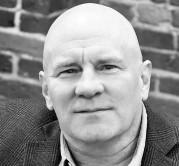Leaders . . . is your cup too full?

One of my old Masters used to tell a story to help us deal with frustration when learning something difficult…
A Master and a student are working on a lesson when the student becomes angry with his lack of ability. “I’m trying as hard as I can––I’m just not getting it.”
The Master takes a cup and fills it nearly to the top with water. He then puts another full cup next to the student. “Now, pour all the water from this cup into the first cup.”
No matter how hard he tried, the student could not put any more water in the cup without it spilling over the side. Angry again he said, “This is stupid. This cup just won’t hold any more water.”
The Master doesn’t say a word. He just takes the first cup and spills it on the ground. He then pours all the water from the second cup into the first.
Sometimes we just have to empty our cup.
As leaders, how many times do we try to add to a cup that’s just too full? How many times do we approach a problem with our minds already made up, entrenched judgments or answers without really knowing the question?
As leaders we’re expected to have answers. We’re expected to provide solutions. But too often what’s required is a step back to listen, learn and assess the situation with a fresh perspective.
Put another way, I often say that the most effective leaders are not those with all the answers––but rather those who are skilled in formulating the right questions.
To do this leaders must practice what martial artists call “no mind.”
In plain English, this means putting aside prejudices, judgments and assumptions. It means keeping the ego in check. And it means listening with the sincere intent to understand the situation and the people involved.
There’s a great scene in the movie The Last Samurai that does a great job of taking the mystery out of this concept.
Tom Cruise plays an American mercenary hired to fight on the side of the Emperor, whose government is trying to eradicate the last holdouts from the feudal age. His character, Captain Algren, is captured by a band of rebel Samurai. Algren tries to learn some of the Samurai ways and starts to practice with the “bokken,” a wooden practice sword.
Every time he spars with his Samurai instructor, he is beaten soundly. Of course he’s angry and frustrated.
One of his Samurai hosts takes him aside and explains, “Too many mind.” Of course Algren is confused. “Too many mind?”
“Hai. (Yes.) Mind the sword. Mind the people watching. Mind the enemy. Too many mind.”
He finished by telling Algren again, “No mind.”
Emptying his mind of all these distractions, Algren scores his first draw with his instructor––a huge moment.
Think about all the things that can keep our mind so full that we have no room for clear thought and effective execution.
- Stress
- Urgency
- Prejudice
- Entrenched beliefs
- Partisan loyalty
- Lack of understanding
- Anger
- Fear
- Over-confidence
- Enthusiasm
- Pessimism
- Optimism
This is just the short list, but notice that not all of these things have automatic negative connotations. In fact, some are almost universally considered positive.
Take “optimism” for example. It’s usually quite helpful for a leader to be optimistic. However––if our optimism blinds us to realistic dangers and rational fears, it can lead us to a false sense of confidence and surety and even to disaster.
The trick is to practice emptying the mind when we’re confronted with an important decision or action. Take the time to consider alternate points of view and solution. With “no mind” we free up cognitive bandwidth to consider new questions and possibilities we might not have considered with a full head predetermined opinions and judgments.
As with many of the leadership skills we practice in THE SENSEI LEADER MOVEMENT, developing “no mind” is simple––not easy. The first steps are:
- Whenever possible, take a breath and take some time to consider other possible solutions, points of view and perspectives––no matter how committed you may be to any particular decision or course of action.
- Make a list of the solutions, responses and questions you already have in mind. Construct alternatives.
- Most of all––practice active, engaged listening. Seek out dissenters and truly listen to their point of view, not to confirm or deny your present view, but to understand.
Sometimes we don’t realize how full our cup is. I think about how difficult it is to drink out of a completely full cup. That’s usually how we end up with a lap full of hot coffee.
Once in a while we’ve got to empty the cup––or at least pour a little out before we take a drink.





